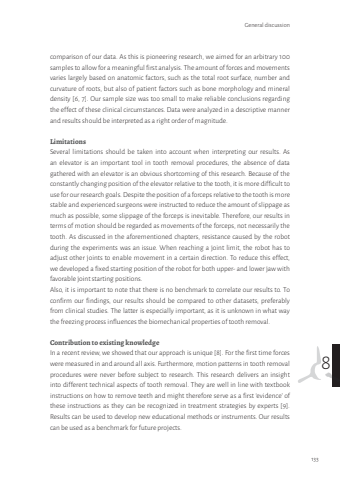Page 135 - Demo
P. 135
8General discussion133comparison of our data. As this is pioneering research, we aimed for an arbitrary 100 samples to allow for a meaningful first analysis. The amount of forces and movements varies largely based on anatomic factors, such as the total root surface, number and curvature of roots, but also of patient factors such as bone morphology and mineral density [6, 7]. Our sample size was too small to make reliable conclusions regarding the effect of these clinical circumstances. Data were analyzed in a descriptive manner and results should be interpreted as a right order of magnitude. LimitationsSeveral limitations should be taken into account when interpreting our results. As an elevator is an important tool in tooth removal procedures, the absence of data gathered with an elevator is an obvious shortcoming of this research. Because of the constantly changing position of the elevator relative to the tooth, it is more difficult to use for our research goals. Despite the position of a forceps relative to the tooth is more stable and experienced surgeons were instructed to reduce the amount of slippage as much as possible, some slippage of the forceps is inevitable. Therefore, our results in terms of motion should be regarded as movements of the forceps, not necessarily the tooth. As discussed in the aforementioned chapters, resistance caused by the robot during the experiments was an issue. When reaching a joint limit, the robot has to adjust other joints to enable movement in a certain direction. To reduce this effect, we developed a fixed starting position of the robot for both upper- and lower jaw with favorable joint starting positions.Also, it is important to note that there is no benchmark to correlate our results to. To confirm our findings, our results should be compared to other datasets, preferably from clinical studies. The latter is especially important, as it is unknown in what way the freezing process influences the biomechanical properties of tooth removal. Contribution to existing knowledgeIn a recent review, we showed that our approach is unique [8]. For the first time forces were measured in and around all axis. Furthermore, motion patterns in tooth removal procedures were never before subject to research. This research delivers an insight into different technical aspects of tooth removal. They are well in line with textbook instructions on how to remove teeth and might therefore serve as a first ‘evidence’ of these instructions as they can be recognized in treatment strategies by experts [9]. Results can be used to develop new educational methods or instruments. Our results can be used as a benchmark for future projects. Tom van Riet.indd 133 26-10-2023 11:59


